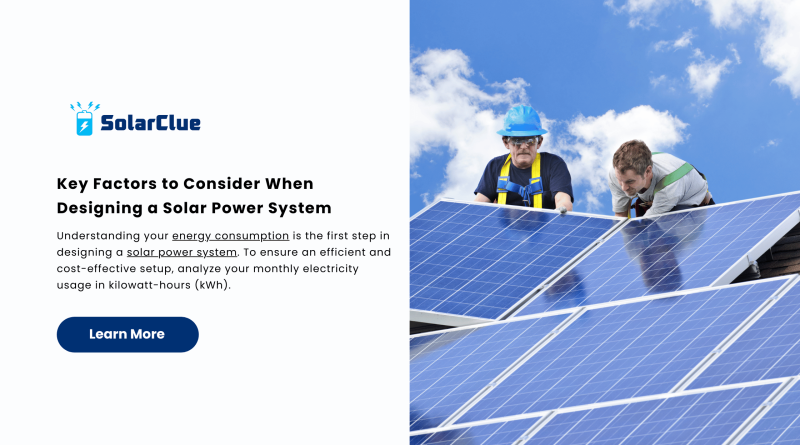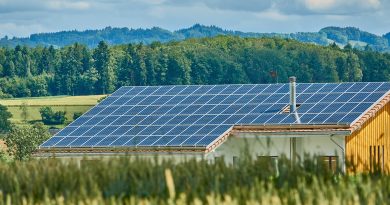Key Factors to Consider When Designing a Solar Power System
Understanding your energy consumption is the first step in designing a solar power system. To ensure an efficient and cost-effective setup, analyze your monthly electricity usage in kilowatt-hours (kWh). Check your electricity bills over the past year to identify patterns in energy consumption. This assessment helps determine the right system size and ensures you generate enough power to meet your needs.
Additionally, consider your future electricity usage. If you plan to add new appliances or an electric vehicle, factor in those energy demands. Proper energy needs assessment avoids undersized or oversized solar PV panel installation, leading to optimal efficiency and savings in the long run.
Table of Contents
- 1 Choosing the Right Solar Panels
- 2 Solar Panel Price and Budget Considerations
- 3 Roof Suitability and Orientation
- 4 PV Panel Installation and Placement
- 5 Selecting a Solar Inverter for Home
- 6 1. String Inverters:
- 7 Evaluating Solar PV Panel Price and Warranty
- 8 Battery Storage and Grid Connectivity
- 9 Maintenance and Durability
- 10 Government Policies and Incentives
- 11 FAQs
Choosing the Right Solar Panels
Different solar panels offer varying efficiency, longevity, and pricing. Understanding the types of photovoltaic panels and their costs helps in making an informed choice.
1. Monocrystalline Panels
These offer the highest efficiency, typically around 18-22%, and have a longer lifespan. However, they are also the most expensive. If you have limited roof space, monocrystalline panels maximize power generation per square foot.
2. Polycrystalline Panels
Slightly less efficient, with an efficiency range of 15-17%, but more affordable than monocrystalline. These are a cost-effective option for homeowners with ample roof space.
3. Thin-Film Panels
These are lightweight, flexible, and ideal for specific applications such as commercial buildings, RVs, and portable setups. However, they have lower efficiency and require more space.
Choosing the right solar PV panel depends on your budget, space availability, and efficiency requirements.
Solar Panel Price and Budget Considerations
The cost of photovoltaic panels varies based on brand, quality, and capacity. Understanding solar module prices helps in making a cost-effective decision.
1. Monocrystalline panels cost more but offer higher efficiency, making them a long-term investment.
2. Polycrystalline panels are budget-friendly but may require more panels to meet your energy needs.
3. Thin-film panels are the most affordable but are not ideal for high energy production needs.
Other cost factors include installation, labor, and additional equipment like inverters and mounting structures. A well-researched budget ensures you get the best solar PV module price while maximizing energy production.
Roof Suitability and Orientation
Your roof’s structure, angle, and direction significantly impact the efficiency of solar panels for home. A south-facing roof with an inclination of 30-45 degrees is ideal for maximizing sunlight exposure.
Check for potential obstructions such as trees, neighboring buildings, or chimneys that might cast shadows on the panels. If your roof isn’t suitable, ground-mounted solar PV panel installation can be an alternative. Proper evaluation ensures maximum energy generation and efficiency.
PV Panel Installation and Placement
Proper solar PV panel installation plays a crucial role in system efficiency. Here are key factors to consider:
1. Shading:
Even minor shading from trees or structures can reduce the panel’s performance.
2. Tilt Angle:
The optimal tilt angle depends on your geographical location to maximize sun exposure throughout the year.
3. Mounting Structure:
Ensure you choose a strong and durable mounting system that withstands weather conditions.
Professional photovoltaic panel installation ensures that the system operates at its highest potential.
Selecting a Solar Inverter for Home
A solar inverter for home is essential for converting DC electricity generated by solar panels into usable AC power. There are three main types:
1. String Inverters:
Ideal for homes with uniform sunlight exposure. They are cost-effective but may lose efficiency if one panel is shaded.
2. Microinverters
Installed on each panel, ensuring maximum efficiency even if some panels are shaded.
3. Hybrid Inverters
These support battery storage and allow for both on-grid and off-grid functionality.
Choosing the right inverter impacts energy conversion efficiency and overall system performance.
Evaluating Solar PV Panel Price and Warranty
When purchasing solar panels, comparing the solar PV panel price and warranty is essential. High-efficiency panels may have a higher upfront cost but provide better long-term returns. Most manufacturers offer:
1. Performance Warranty
Ensures at least 80-90% efficiency even after 25 years.
2. Product Warranty
Covers defects and damages, typically lasting 10-25 years.
Investing in a reputable brand with a solid warranty ensures reliability and long-term savings.
Battery Storage and Grid Connectivity
Deciding whether to install battery storage is crucial. Batteries store excess solar energy for use at night or during power outages. If you opt for a grid-connected solar power system, you can sell surplus electricity back to the grid through net metering.
Battery storage adds cost but provides energy independence. Lithium-ion batteries are the most popular due to their high efficiency and long lifespan.
Maintenance and Durability
Photovoltaic panel installation requires minimal maintenance. Regular cleaning ensures panels remain free of dust and debris, improving efficiency.
Here are maintenance tips:
1. Periodic Cleaning
Remove dirt and bird droppings to avoid power loss.
2. Inspection
Check for loose wires, corrosion, and physical damage.
3. Inverter Monitoring
Ensure the inverter functions properly to avoid power conversion losses.
A well-maintained system ensures optimal performance for 25-30 years.
Government Policies and Incentives
Many governments offer incentives to encourage solar adoption. Check for available subsidies, tax credits, and net metering policies in your region to reduce the overall solar PV module price. These incentives help homeowners save money and increase their return on investment.
FAQs
1. How much does a solar power system cost?
The cost of photovoltaic panels varies by type, brand, and capacity.
2. What affects solar PV module price?
Solar PV module price depends on efficiency, brand, and wattage.
3. Can I install solar panels for home without a battery?
Yes, but battery storage helps store excess energy for backup.
4. How long does solar PV panel installation take?
PV panel installation usually takes 1-3 days, depending on the system size.
Need help? Your answers are just a click away on our website!


